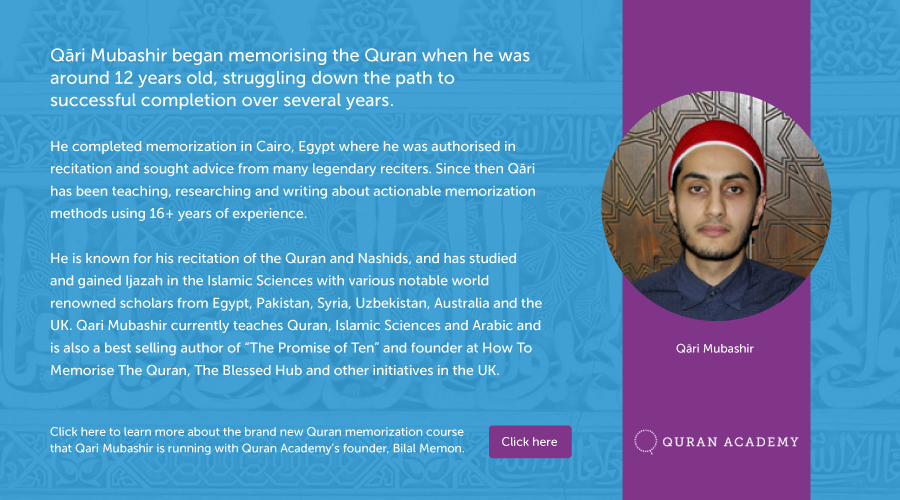
In the first and second part of this series, we covered memorization tips for visual and auditory learners. If you haven’t discovered your learning style yet, take this quiz to find out.
Let’s now dive into Quran memorization tips for reading/writing & kinesthetic learners.
>>> Form a meaningful relationship with the Quran in as little as 10 min/day. Learn more.
Are You a Reading/Writing & Kinesthetic Type of Learner?
Here are some of the most common strengths and characteristics these learners have:
- They move around a lot
- They prefer not to sit still
- They move a lot while studying
- They like to participate in learning
- They like to do things rather than read about them
- They do not prefer reading
- They do not spell well
- They enjoy problem solving by doing
- They like to try new things
- They talk with hands or gestures
- They select clothes according to comfort
- They like to touch objects
The following is what they tend to do as learning aids:
- They practice by repeating motions
- They write words; use markers, pens, pencils to see if they “feel right”
- When memorizing, they use a finger to write on the table or in the air
- They associate a feeling with information
- They stretch
- They write on a white board in order to use gross muscle movement
- They use the computer
- Study in short time periods; get up and walk around in between
- They make study tools to hold like using flashcards; that separate into “know” and “don’t know” piles
- They use plastic letters and magnetic boards for new vocabulary
- They write and rewrite to commit to memory
Tips to Help You Memorize the Quran
Write down the letters of each verse
One of the problems many face when memorizing is linking verses. Especially when trying to recall the start of the next page. One way to deal with this is by writing down the first letter of every word on a separate sheet of paper as you read or recite the verse. One of my students felt the need to do this when memorizing specific chapters. He’d do it in English by simply writing down what the first word of each verse on the page. It worked!
Use a pencil whilst reading
Another technique is to trace or follow the words with your finger as you read from the Quran or from a Quran app. Many have found that using a pencil or touch pen is far more effective. It gives the reader more focus and a great way to reinforce memorization through sense of touch.
The Quran Companion app has a neat Swipe feature function that allows you to hide the verses you are memorizing. Using your finger you can reveal the verse bit by bit whilst testing yourself. That’s worth checking out.
Get physical
This technique is especially good for those with a busy schedule. Quran memorization apps are great tools for this very purpose. You can play the audio of the verses you want to memorize on loop while driving, exercising, or doing housework.
In many places within Africa, Muslim Quran institutions use movement as a tool to aid memorization. In one class, ‘Abdul Halim in West Africa told me that they use writing slabs in class. The students sit in a circle and the teacher is in the middle. Whilst sitting they memorize new verses but everyone has to stand up and walk around in a circle when revising.
The teacher recognized that the students were too bored sitting around and this method did the trick. If you memorize with a Mushaf, you can always move around whilst reading. Myself and my students do it all the time (they even play with a ball). It gives us more focus and motivation.
Competitive games
For two of my students, I had to invent two games on the spot in order for them to begin memorization starting with the letters. I recognized that they weren’t good with books (both young boys) and so within the class, I told them to put the books away. We then made a board game together where he’d compete against me and another.
For the other boy, I asked him to play a competitive game involving forwards and backwards small and large steps. They had to answer questions and recall words or verses, if they got it right they moved one step closer to the target, if they got it wrong, they move one step backwards.
These are all effective means to utilize when trying to memorize.
What Can You Do – Try Different Methods
In this series we’ve spoken about visual, auditory, read/write and kinesthetic learners and what they can do when memorizing the Qur’an.
We’ve learnt that visual learners should take advantage of drawing, writing and mindmaps. Auditory learners should take advantage of listening, recording, group memorization, teaching, storytelling, verbal games and even flashcards. We saw in this post that read/write and kinesthetic learners can use competitive games, combining reading with physical activity, writing and using a pencil/finger as an aid.
This brings me to my last point.
Despite knowing that we are all different and have different strengths in learning, the world is not as black and white. That is why the VARK model provides four scores and also why there are mixtures of those four modes. Those who do not have a standout mode with one preference score well above other scores, are defined as multimodal.
They are of two types. There are those who are flexible in their communication preferences and who switch from mode to mode depending on what they are working with. They are context specific. They choose a single mode to suit the occasion or situation. If they have to deal with legalities they will apply their read/write preference. If they are to watch the demonstration of a technique they will be expressing their kinesthetic preference.
There are others who are not satisfied until they have had input (or output) in all of their preferred modes. They take longer to gather information from each mode and, as a result, they often have a deeper and broader understanding. They may be seen as procrastinators or slow-deliverers but some may be merely gathering all the information before acting – and their decision making and learning may be better because of that breadth of understanding.
And so the best benefit comes from a mixed modality, for instance I used auditory, visual and read/write techniques for myself and many of my students. What I like about the Quran Companion app is that it uses every multisensory feature to aid memorization.
Insha’Allah this series proves to be beneficial for you.
Good luck, may Allah bless you in your Quran memorization efforts, and remember, this is a long-term journey. Stay consistent, even if it’s small, and you will reach your goal successfully.
For more tips, I’ll be teaching a course with the founder of Quran Academy, Bilal Memon. The memorization course is called, “Building the Foundation of Effective Quran Memorization: A 6-Week Step-by-Step Live Course Covering the Psychology, Tools & Long-Term Strategies that Unleash Your Inner Hifdh.“
You can learn more about the course by clicking the image below.





Leave a Reply